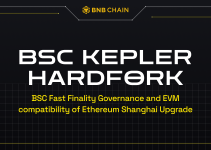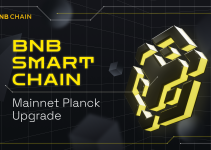Table of Contents

Scalability has arisen as a major concern in Web3 and decentralized applications. Scalability, security, and decentralization are known trilemma within blockchain technology, and Layer 1 (L1) networks can face the challenge of network congestion during peak periods.
Network congestion can lead to high transaction fees, slow transactions, and poor user experience. As such, there is a need to improve scalability for L1s, and the opBNB is a layer 2 solution that enhances the performance and scalability of the BNB Smart Chain (BSC) network. opBNB leverages the Optimism OP Stack Bedrock, an open-source modular optimistic rollup framework that can be modified to meet BSC ecosystem requirements.
L1 Scaling’s Difficulty
Blockchain networks built on Layer 1 have grown tremendously recently, including BNB Smart Chain (BSC). Most L1 networks, however, were not originally built to handle the ever-increasing transaction volumes and complicated smart contracts associated with popular decentralized applications. As a result, network congestion and increasing fees have become the norm, degrading user experience and impeding blockchain technology’s general adoption.
For example, BSC had a web3 game on its chain in 2021, which generated over 8 million transactions per day. Such volumes put stress on BSC’s throughput capacity and resulted in slowed transaction speeds and delayed transaction finality. Overall, the user experience for the game players and users of other dApps was impacted. Furthermore, gas fees can also become a barrier.
Immense transaction loads from a dApp on such a large scale seem infeasible for BSC and the dApps within its ecosystem. The restrictions of L1 scalability stifle innovation and hinder blockchain technology from reaching its full potential. As such, significant optimizations and scaling solutions are needed for BSC to support such a dApp without network-wide performance degradation and unreasonably high costs.
The result of recognizing these challenges was to create opBNB as a Layer 2 scaling solution based on OP Stack. The OP Stack is a framework for building scalable and interoperable layer-2 solutions based on utility, simplicity, and extensibility principles.
How is Economical Scaling possible?
The OP Stack was heavily relied on as the foundation of opBNB, enabling opBNB to achieve several benefits, such as modularity. opBNB allows the customization of models, such as a more flexible execution where performance can be optimized. Additionally, different data access layers for data scalability enhancements can be achieved, along with adopting different types of proof generation logic, including zero-knowledge proofs.
The efforts and innovations introduced by Optimism to the OP Stack framework have been instrumental in fostering open and collaborative ecosystems that encourage different projects to work together in mutually beneficial ways. The opBNB joins a network of other layer 2 chains that innovate using the OP Stack, achieving interoperability.
As compressed layer 2 transaction data is posted on-chain while transactions are processed off-chain, scalability is provided. opBNB consists of three major layers: an operator interface layer for proposing layer 2 transactions off-chain, an RPC service layer for engaging with the rollup, and an execution layer for carrying out transactions and offering an EVM execution environment. Due to the rollup’s modular nature, many methods can be used to create the data availability interface and settlement layer.
As transaction data is recorded on-chain, the rollup is safeguarded by its settlement chain and uses consensus and data availability solutions. It lacks permission and is decentralized. Compared to BSC, the roll-up offers cheaper and faster transactions while being secure.
There are a few ways in which opBNB achieves performance and lower fees:
- The optimization of the execution layer.
- EVM State Data Access Optimization by avoiding unnecessary recursive accesses to Diff Layers by increasing the accuracy of Bloom Filter, Making Prefetch more effective.
- Mining Process Optimization through adding block receipt cache after block import.
- And lastly, the optimization of more batches through the introduction of community-developed parallel submission and synchronization of confirmation.
You can read about the full outline of opBNB’s architecture here.
Using opBNB to Build: Unleash Your Creativity
For developers, opBNB offers an opportunity to create scalable, high-performance decentralized applications. Developers can unleash their creativity without the constraints of L1 scaling by using opBNB as the foundation for their projects. Whether creating a gaming app, a social network, or a new DeFi protocol, opBNB’s architecture enables you to build game-changing solutions with unrivaled scalability. DApps that require a more complex interaction of smart contracts can look to opBNB.
Developers can use opBNB to construct applications that provide rapid transaction speeds and near-instant confirmation, providing a smooth user experience. Furthermore, opBNB greatly reduces transaction costs, making frequent interactions with decentralized applications economically viable.
Are you a blockchain engineer willing to push the frontiers of the technology? Join the opBNB revolution and take advantage of Layer 2 scaling. You may unleash endless possibilities, overcome the limitations of L1 scaling, and build scalable apps that will define the future of decentralized finance and beyond by incorporating opBNB into your projects.
Explore the developer documentation, access useful tools, and join a thriving builders community by visiting today’s opBNB website. Let us work together to change the blockchain landscape and usher in a new scalability, efficiency, and innovation era.
Acknowledging those making opBNB possible
The OP Stack framework provided opBNB with a tested and robust framework, enabling quicker and simpler deployment of scalable Layer 2 infrastructure. Not only did the BNB Chain community, like the broader Layer 2 ecosystem, benefit from these open-source optimization.
opBNB codebase is fully open source, and all the optimizations in opBNB can be reused in other optimistic rollup implementations. We hope this work will inspire collaboration and innovation among EVM-compatible blockchain developers and users.
The scalability of blockchains has long been a barrier to the growth and adoption of decentralized apps. However, developers now have options to bypass the limits of L1 scaling with opBNB. With opBNB, developers can create scalable applications with high throughput, low fees, and a seamless user experience. Come explore the possibilities with opBNB.


